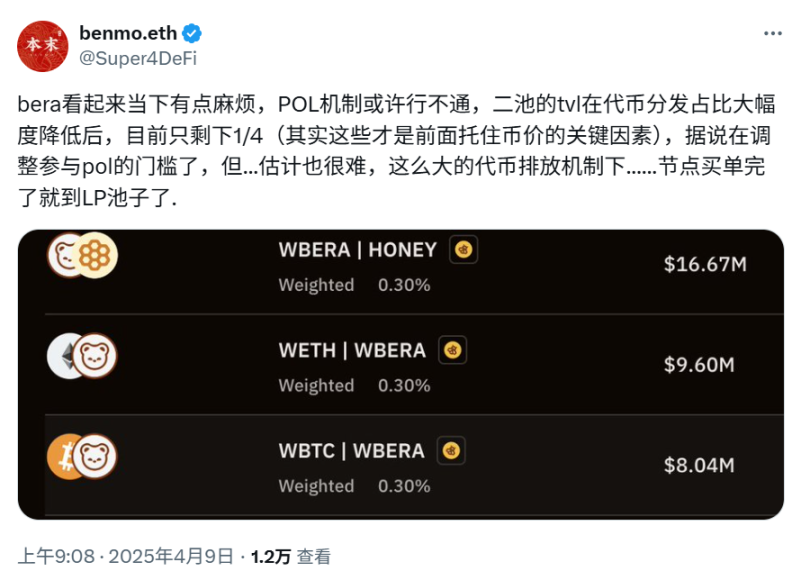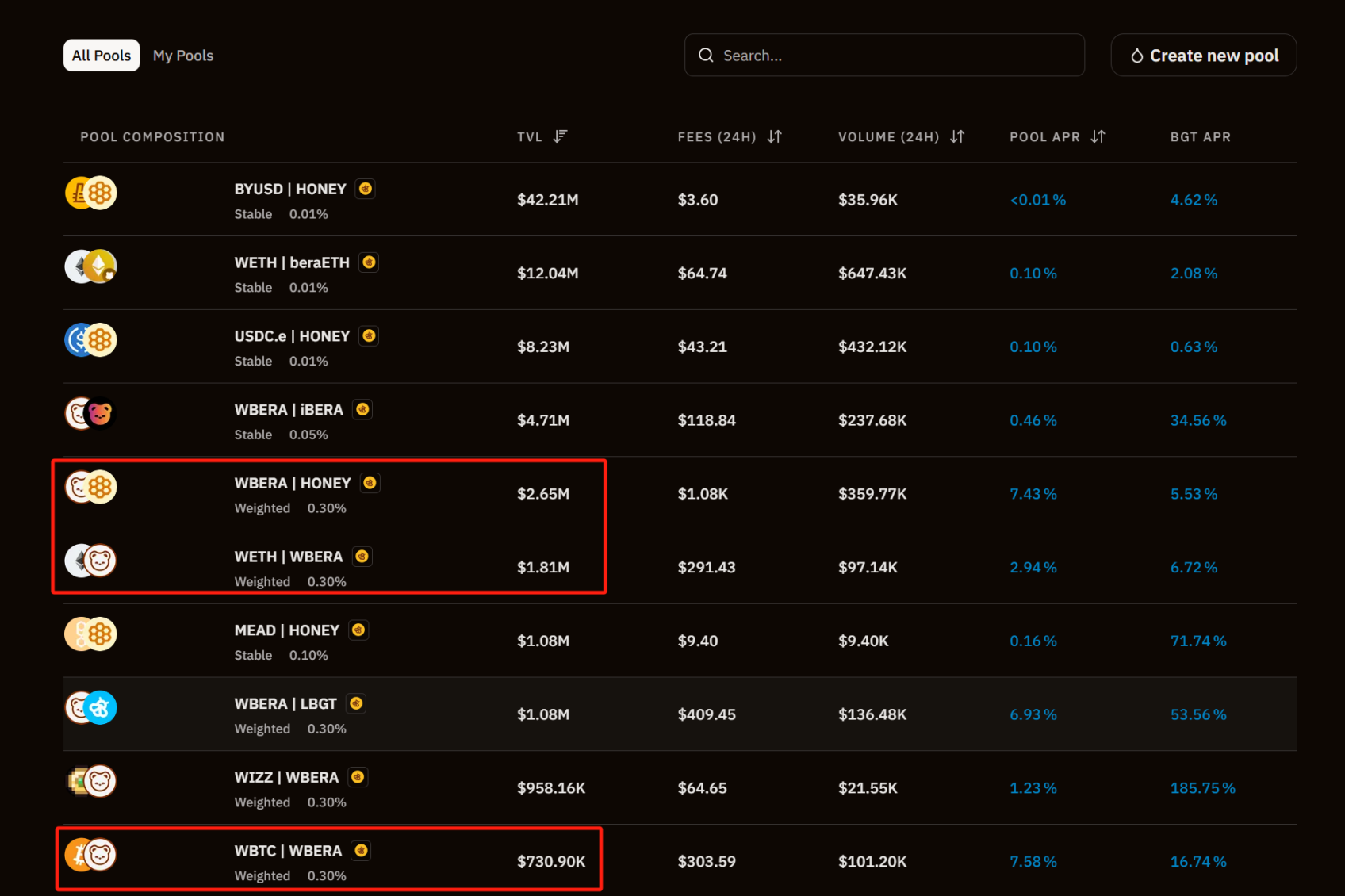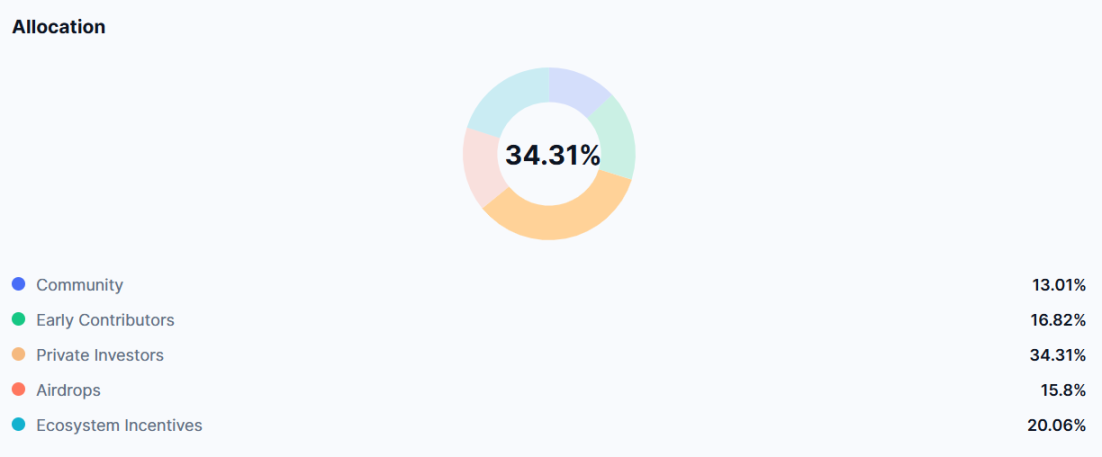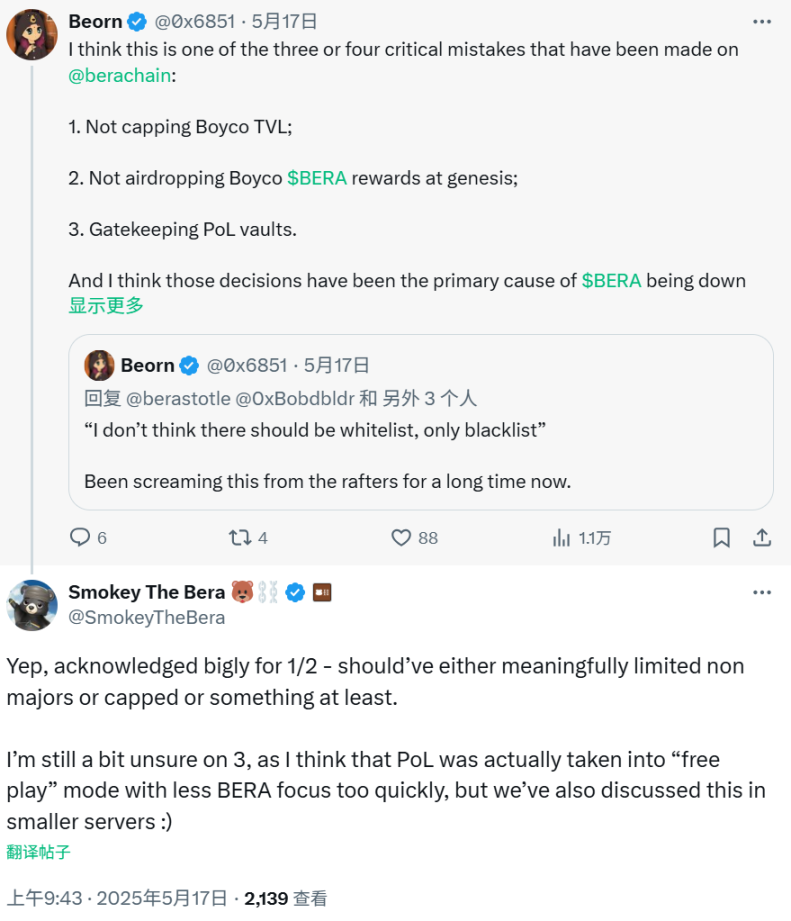Berachain's TVL has dropped 67% from its peak.
Written by: 1912212.eth, Foresight News
Recently, the price of BERA fell to $2.66, marking a new low since the TGE in February this year. Since March, BERA has been on a downward trend. What has happened to the once-prominent Berachain?
TVL plummeted from $3.4 billion to $1.147 billion, a decline of over 67%
As an emerging public chain, Berachain attracted significant market attention even before launching its mainnet due to its meme culture, liquidity mechanism, and support from well-known VCs. Its core innovation lies in its Proof of Liquidity (PoL) mechanism, which incentivizes on-chain liquidity through BGT emissions and bribery. However, the complexity of this mechanism has made it difficult to attract new users and has exposed sustainability issues. PoL relies on a continuous injection of liquidity, but when market conditions worsen or incentives decrease, liquidity providers quickly withdraw, leading to a significant drop in total locked value.

According to data from defiLama, its total TVL has fallen from a peak of $3.493 billion on March 28 to the current $1.147 billion, a decline of over 67%.
As early as the beginning of April this year, well-known arbitrage KOL Benmo tweeted that Berachain might face issues, as the TVL of its second pool had significantly decreased in token distribution proportion, and the token emission mechanism was problematic, suggesting that its PoL mechanism might not work.

Recently, the liquidity pool TVL shown in the above image has experienced an even larger decline.

These three liquidity pools are the core liquidity pools of Berachain. Due to the reduced token incentive distribution ratio under the PoL mechanism (especially in the "second pool," which is not the main pool), liquidity has rapidly flowed out. This reflects three key issues: liquidity providers lack long-term confidence, and they flee as soon as incentives decrease. The mechanism relying on token incentives to maintain the ecosystem is unstable; there is insufficient real demand, and attracting users solely through "airdrop farming" is inadequate.
A considerable amount of BGT released has been allocated to BERA and BGT liquidity tokens as deposited asset vaults, while other assets have few users and trading volumes. More than half of the bribes also come from WBERA, BGT derivatives, and HONEY, raising concerns about the structure of the bribery assets.
In the long run, if this issue is not resolved, the mining pool will eventually collapse.
10 million unlocked BERA tokens create market selling pressure
On May 6, Berachain officially unlocked 10 million BERA tokens, primarily through airdrops. If calculated at a unit price of $3, the total value amounts to approximately $30 million in selling pressure. As mentioned earlier, most users participating in Berachain are arbitrage players, and once incentives decrease, they quickly choose to leave. Mining and selling has become a common practice.
Additionally, BERA has long been criticized as a typical VC token, with 34.31% of its total supply allocated to private investors. In comparison, VC shares typically fluctuate around 20%, while the nearly 35% allocation has drawn significant criticism for BERA as a VC token.

Smokey the Bera, the anonymous co-founder of Berachain, stated in an interview with Un Chained that he "does not believe the criticism is entirely wrong. If we could do it all over again, and the team could start from scratch, we might not sell so much supply to venture capital firms. In fact, most of the supply was sold during the seed round in early 2022. At that time, we thought it could be an interesting thing, but we didn't expect it to develop to such a large scale now. So I think these criticisms are valid. In fact, over time, we have been working to buy back that portion of the seed round and subsequent A round supplies to minimize the dilution suffered by the community."
After the market's enthusiasm quickly dissipated, the buying pressure for BERA tokens has been under pressure, making it difficult for the price to rise.
Co-founder admits mistakes again: "Did not set Boyco TVL cap"
In mid-May, Smokey the Bera admitted to making mistakes during an interaction with the community in the comments section, including not setting a Boyco TVL cap and not distributing BERA incentives to it.

Why do these two mistakes have negative impacts? The higher the TVL, the rewards should non-linearly decay or have a cap to prevent excessive capital concentration and "plundering" of incentives. Without a cap, the larger the TVL, the more tokens are obtained, allowing large holders like Boyco to infinitely cycle and extract BERA incentives. This mechanism effectively defaults to "whoever has more money leads," completely breaking fairness.
Incentives should also stimulate diverse ecological participation through PoL, but the result has led to important tokens like BGT and HONEY being almost entirely harvested by a few individuals, directly triggering community dissatisfaction and a trust crisis. Once other users discover that the incentives are entirely consumed by large holders, they will choose to exit or observe, creating a liquidity avalanche effect.
"Not distributing BERA incentives to participants in the Boyco event" has become another point of dissatisfaction in the community. If the protocol sets an incentive model, and the project side skips incentive distribution without announcement, it essentially violates on-chain rules, making any large capital participant uneasy: will my rewards also be arbitrarily canceled in the future?
Well-known airdrop farming KOL Ice Frog commented on this incident, stating, "Months have passed, Berachain repeatedly admits mistakes, yet they just can't learn how to change?" He further questioned, "This only indicates that they knew about these problems from the beginning, and they have not ignored community feedback or been unaware of where the problems lie. They just never thought about changing from start to finish."
So, has Berachain really taken action to "improve" recently? At least in terms of airdrop incentives, there has been no change.
However, recently, the official announced an upgrade at the protocol level that introduces configurable BGT distribution reward durations. Vault managers can now set the reward period to 3 to 7 days, with a 1-day cooling period between changes. All newly created vaults will default to a 7-day cycle. This change provides the team with greater flexibility, allowing the emission pace to better align with vault strategies and user experiences.
Additionally, proposals for upgrades around PoL are also underway.
BERA value capture still needs to be strengthened
BERA is the gas token for all transactions and smart contract executions on the Berachain network, serving as a pure consumable. The incentives on the protocol essentially extract value from Berachain with high bribery efficiency.
The BERA token also lacks governance rights, which are instead given to BGT holders, further weakening the value of BERA.
BERA urgently needs more value capture mechanisms.
The co-founder of Berachain announced its POL V1.1 proposal on May 11, hoping to strengthen BERA's value capture mechanism while maintaining incentive efficiency. Its core content includes: the protocol will collect a small portion of the bribery incentives for ecological applications, deploying them to Protocol owned liquidity to establish core trading pair LPs for BERA (such as BERA-HONEY, BERA-wBTC on BEX), thereby achieving:
- Enhancing the depth and stability of on-chain base trading pairs,
- Reducing BERA circulation,
- Increasing long-term sources of fee income (initial income prioritized for deployment to major trading pairs; later can be used for staking to foundation-operated validator nodes and directed distribution of BGT to native application RVs, delegating to innovative application-operated nodes, forming new LPs with other mainstream assets, deploying to other native protocols like Bend, Berp, etc.)
The proposal suggests initially charging a fixed 20% of the incentive redistribution fees and gradually introducing a dynamic rate model:
- High bribery incentive efficiency → lower fee rate
- Low bribery incentive efficiency → fee rate increases
- Control range set at 10%-30%, adjusted in line with market conditions. This mechanism encourages efficient resource use and forms a feedback loop with actual application performance.
Recently, Smokey revealed that a new PoL proposal v1.2 will be released soon, expected to strengthen the token's value capture after integrating feedback from various parties.
Summary
Once as bustling and lively, now it is equally silent. After a prolonged period of lackluster prices, the Berachain community has quickly become quiet. How Berachain will truly address the issues remains uncertain, but time waits for no one. If the official actions remain slow, they may soon be abandoned by the community.
免责声明:本文章仅代表作者个人观点,不代表本平台的立场和观点。本文章仅供信息分享,不构成对任何人的任何投资建议。用户与作者之间的任何争议,与本平台无关。如网页中刊载的文章或图片涉及侵权,请提供相关的权利证明和身份证明发送邮件到support@aicoin.com,本平台相关工作人员将会进行核查。




